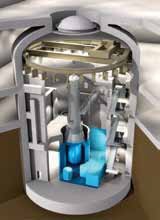Go Big and Go for the Hill
DISCOVER Magazine recently joined forces with the National Science Foundation, the American Society of Mechanical Engineers and the Institute of Electrical and Electronics Engineers to hold a series of briefings on Capitol Hill. Four “bold ideas” were presented by eight leading energy scientists to politicians with the hope that these alternative energy solutions could be implemented in the near future.
Reeingineer the Grid
The Department of Energy has predicted that there will be 1.2 million plug-in hybrids and electric vehicles on the road by 2015, so in preparation, the energy grid needs to be rearranged. Electricity generation from coal-fueled plants and transportation are responsible for 33 percent and 27 percent of America’s carbon emissions, respectively. Jeffery Stein, a University of Michigan mechanical engineer, states, "At first it may seem counterintuitive that making cars electric will help us limit greenhouse gases, but in fact we can reduce carbon emissions by adopting vehicle electrification."

© 2010 Babcock & Wilcox Nuclear Power Generation Group, Inc. All rights reserved.
Mini Nuclear Reactors
Nuclear power is the cleanest source of energy on a large scale, but nuclear reactors are often costly and do pose safety risks. The solution: small modular reactors. Daniel Ingersoll, a nuclear engineer at Oak Ridge National Laboratory, states, "[S]mall modular reactors offer a better way to harness nuclear energy to produce power." In addition, the smaller modules are safer and much more affordable than conventional nuclear plants.
Natural Gas Popsicles
Natural gas, the cleanest-burning fossil fuel, produces approximately half as much carbon per watt of power as coal and supplies 25 percent of America’s electricity. There are enough global frozen deposits where natural gas exists in the form of methane gas hydrates that, if tapped, could power the U.S. for 1,000 years at the current rates of consumption. Gas turbines use the natural gas to produce electricity, and thanks to a project funded by the Department of Energy, the efficiency of gas-fired power plants has been increased to 60 percent.
Power of Pond Scum
Algae are the most efficient source of biofuel, with some algae species containing up to 60 percent oil -- and genetic engineers believe they can increase this amount. The algae do not compete with farmland or food, which is the problem with other biofuels. "They are sustainable, highly productive, and easy to cultivate, and they capture carbon dioxide," states University of Nebraska at Lincoln biochemist Donald Weeks.
Classroom Discussion
- Which of these options do you think sounds the most feasible?
- Is there an alternative energy option that is missing from this? What argument can you make for it?